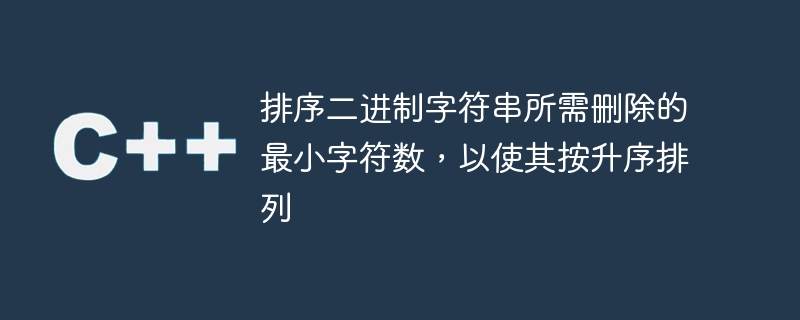

In computer science, string manipulation is an important topic, involving operations such as splicing, substrings, and reversal. A common problem related to string manipulation is removing all zeros from a binary string. In this article, we will discuss an algorithm that uses a minimum number of non-adjacent pair flips to solve this problem.
Given a binary string, we must remove all 0's in the string using a minimum number of non-adjacent pair flips. Flip is defined as selecting two adjacent characters and swapping them. In other words, we need to find the minimum number of flips required to bring all 0s in the string to the end of the string.
We can use a greedy algorithm to solve this problem. We can start at the left side of the string and keep track of the last index where we flipped 0 to the end. For each encountered 0, we swap its position with the last flipped 0, moving it to the end of the string. If 1 is encountered, we simply move to the next index.
Let’s look at the algorithm in detail -
Initialize the two variables "lastFlipped" and "flipCount" to -1 and 0 respectively.
Traverse the binary string from left to right.
If the current character is "0", swap it with the character at index "lastFlipped 1" and increment the "lastFlipped" variable.
Increase the "flipCount" variable for each swap operation.
After the traversal is complete, all 0s will be at the end of the string and "flipCount" will contain the minimum number of flips required to remove all 0s.
This is the C code used to implement the above algorithm -
#include <iostream>
#include <string>
using namespace std;
int minNonAdjacentPairFlips(string s) {
int lastFlipped = -1;
int flipCount = 0;
for (int i = 0; i < s.length(); i++) {
if (s[i] == '0') {
swap(s[i], s[lastFlipped + 1]);
lastFlipped++;
flipCount++;
}
}
return flipCount;
}
int main() {
string s = "100101000";
cout << "Binary String: " << s << endl;
cout << "Minimum Non-adjacent Pair Flips: " << minNonAdjacentPairFlips(s) << endl;
return 0;
}
Binary String: 100101000 Minimum Non-adjacent Pair Flips: 6
We take the binary string "100101000" as an example. We must remove all 0's from the string using a minimum number of non-adjacent pair flips.
Initially, "lastFlipped" and "flipCount" are set to -1 and 0 respectively.
We start traversing the string from left to right.
At index 1, we encountered a '0'. We swap it with the character at index "lastFlipped 1" (i.e. index 0) and increment "lastFlipped" to 0. The string becomes "010101000". "flipCount" is increased to 1.
At index 4 we encounter another '0'. We swap it with the character at index "lastFlipped 1" (i.e. index 1) and increment "lastFlipped" to 1. The string becomes "011010000". "flipCount" is increased to 2.
At index 5, we encounter a '1'. We just move to the next index
In this article, we discuss an algorithm to remove all 0's from a binary string using a minimum number of non-adjacent pair flips. The approach used by this algorithm is greedy, which makes it efficient and easy to implement. We also provide C code for implementing the algorithm along with sample test cases.
This problem can also be solved using dynamic programming, but the greedy algorithm provides a simpler and faster solution. The time complexity of this algorithm is O(n), where n is the length of the binary string.
In short, the minimum non-adjacent pair flipping algorithm is a useful tool in string operations and can be applied to various situations.
The above is the detailed content of Minimum number of characters needed to be removed to sort a binary string so that it is in ascending order. For more information, please follow other related articles on the PHP Chinese website!




